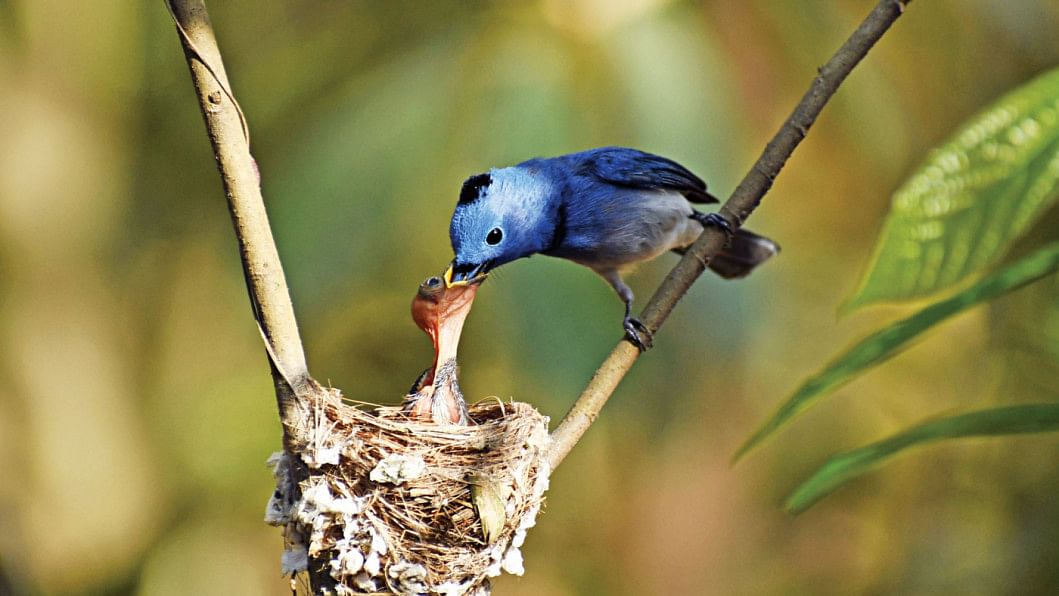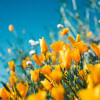Capturing the avian wonders of northern Bangladesh
If journalism is my profession, wildlife photography is my passion. For me, it's not just about snapping a picture -- it's a form of meditation, a way to escape from the everyday noise and stress.
Whenever I get a chance, I immerse myself in photographing birds.
The time, money, and attention it demands are worth every bit of effort because they lead me to a place of peace.
When I look through the viewfinder of my camera, it's as if I am stepping into a different world, one where I can immerse myself fully in the beauty and behaviour of wildlife.
I remember vividly the excitement of seeing a paradise flycatcher darting through a bamboo bush, its tail flickering with each movement. Or the serene joy of watching a mother black-naped monarch feeding her hungry chicks. Each of these moments requires my full attention, and in those instances, all my worries and anxieties melt away.
Bird photography offers me a refuge from work pressures, boredom, and grief.
In those quiet moments spent waiting for the perfect shot, I find a kind of peace that's hard to describe. Over 600 bird species provide endless opportunities for discovery, and each encounter deepens my appreciation for nature.
For me, photography isn't just an addiction -- it's a way to find balance and tranquillity in a hectic world.

AVIAN DIVERSITY IN BANGLADESH
Over 600 bird species paint a rich portrait of diversity in Bangladesh's vibrant avian landscape.
Of these, 300 are resident birds, gracing our land throughout the year.
Yet, the winter months bring a spectacular transformation as more than 100 migratory species converge upon our wetlands, while an additional five to eight species make their appearance during summer.
The northern districts of Bangladesh, particularly the sprawling 1,000-hectare Jaboi Beel in Naogaon's Sapahar upazila are renowned bird hotspots.
Here, the convergence of expansive water bodies and abundant food sources attracts around 30 species of birds each winter.
Among these, the Lesser-whistling Duck, Red-crested Pochard, Garganey, and Tufted Duck grace the beel with their presence, while the likes of the Black-winged Stilt, Ruff, and Little Stint add to the spectacle.
The avian population of Jaboi Beel also includes the Purple Heron, Indian Pond Heron, and the striking Pied Kingfisher.

BIRDLIFE ALONG THE INDIAN BORDER
In Chapainawabganj, adjacent to the Indian border, Chorol Beel stands as another sanctuary for migratory birds.
Here, Lesser Adjutants, known locally as Motontak, roost in large trees in the borderlands, foraging in the beel's marshes.
Classified as near threatened by the IUCN, these majestic birds find refuge in this relatively undisturbed habitat.
As summer arrives, the Plum-headed Parakeet, predominantly from neighbouring India, visits the Badalgachi Upazila in Naogaon.
This colourful visitor is drawn to the aush paddy and grass seeds abundant in the region. Despite their seasonal migration, wildlife experts note that Plum-headed Parakeets are permanent residents in the Habiganj district.
RAJSHAHI'S MIGRATORY BIRD HAVEN
Rajshahi's char areas along the Padma River are also a haven for migratory and rare birds.
The shoal areas of the Padma River, with their rich food supply and minimal human interference, provide an ideal sanctuary.
As winter approaches, the influx of migratory species is a common sight, with some rare storks like the Black Stork and Woolly-necked Stork making their appearance.
Rajshahi's large mobile towers, repurposed by storks for nesting, offer a unique glimpse into their breeding habits.
However, the rise in bird photography, while celebrating the beauty of these creatures, has inadvertently led to increased disturbances.
The close proximity of photographers can unsettle the birds, potentially impacting their natural behaviours and habitats.

ASIAN OPENBILL STORK IN BOGURA
In Bogura, a rich diversity of bird species can be seen throughout the year.
Among the most prominent avian communities is a large colony of Asian Openbill Storks in Shibganj upazila.
This place is just one of over 100 such colonies scattered across the country.
"Surprisingly, these birds are now found in large numbers in almost every part of Bangladesh," said SM Iqbal, a wildlife expert and professor at the Zoology Department of Bogura Azizul Haq College.
"No other bird has spread as fast as the Asian Openbill Stork. It was only a summer visitor here 15 to 20 years ago, but now it has become a permanent resident," he added.
The Asian Openbill Stork's remarkable adaptability has allowed it to establish two types of colonies in the country. According to Prof Iqbal, "These birds form temporary colonies where they collect food from neighbouring districts, while their breeding takes place in more permanent colonies."
VIBRANT INDIAN PITTA
Alongside the storks, another vibrant species graces the skies of Bogura during the monsoon season -- the Indian Pitta, known locally as Bonsundari. This colourful bird, with its striking plumage, returns year after year to the same spots, a natural phenomenon that has captivated birdwatchers and experts alike.
"The most surprising thing about the Indian Pitta is its loyalty to its chosen habitat," Iqbal explained. "Once it visits a place, it comes back every year. Eventually, its descendants return to these areas to reproduce, keeping the cycle of life ongoing."

ASIAN PARADISE FLYCATCHER: A SHY BEAUTY
According to bird specialists, around 95 percent of Bangladesh's endemic birds breed between February and September. Among the native species, the Asian Paradise Flycatcher stands out as a favourite for birdwatchers and photographers alike.
This enchanting bird, with its delicate form and graceful flight, constructs nests resembling tiny teacups in the shelter of bamboo bushes or other secluded areas during the summer.
True to its name, the flycatcher remains airborne for much of its life, never touching the ground as it catches insects mid-flight.
The male of the species undergoes a stunning transformation, changing from a reddish-brown hue to a striking white after three years.
When it flies through bamboo groves, its long, flowing tail gives the illusion of a fairy gliding before your eyes.
Despite its ethereal beauty, the Asian Paradise Flycatcher is known for its shyness, often avoiding human contact.
However, during the breeding season, these birds make a curious exception. To protect their young from predators, they build their nests on low-hanging branches, often within plain view of humans, using proximity to people as a deterrent to other birds.
A DELICATE BALANCE BETWEEN MAN AND NATURE
This delicate balance between the natural world and human life serves as a reminder of our deep connection to the environment. The flora and fauna that surround us play a crucial role in our survival, and birds, in particular, are among our closest companions in nature. Their songs, colours, and behaviours enrich our daily lives in ways we often overlook.
In this shared world, it becomes our moral duty to protect and care for these winged creatures.
Birds are more than just fleeting visitors to our landscapes; they are vital players in the ecosystems that sustain us.
As guardians of the skies, they remind us of the harmony that exists between all living beings, and it is up to us to ensure that this harmony is preserved for future generations.

 For all latest news, follow The Daily Star's Google News channel.
For all latest news, follow The Daily Star's Google News channel. 






Comments